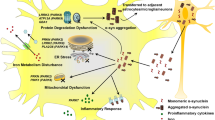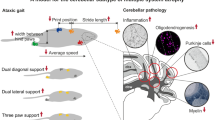Abstract
Several studies have suggested that increases in astrocytic monoamine oxidase B (MAO-B) levels in conjunction with Parkinson’s disease (PD) may contribute to subsequent neuropathology associated with the disorder. MAO-B inhibitors are currently widely used as symptomatic therapeutics for PD and, although somewhat controversial, these drugs may also exhibit disease-modifying properties. To obtain a better understanding of the potential role of MAO-B in disease neuropathology, we created an inducible astrocyte-specific transgenic MAO-B mouse model. Here, we summarize findings associated with this model, including neuropathological PD features associated with it.


Similar content being viewed by others
References
Antkiewicz-Michaluk L (2002) Endogenous risk factors in Parkinson’s disease: dopamine and tetrahydroisoquinolines. Pol J Pharmacol 54(6):567–572
Bernheimer H, Birkmayer W, Hornykiewicz O, Jellinger K, Seitelberger F (1973) Brain dopamine and the syndromes of Parkinson and Huntington. Clinical, morphological and neurochemical correlations. J Neurol Sci 20(4):415–455
Bhat R, Crowe EP, Bitto A, Moh M, Katsetos CD, Garcia FU, Johnson FB, Trojanowski JQ, Sell C, Torres C (2012) Astrocyte senescence as a component of Alzheimer’s disease. PLoS One 7(9):e45069
Bitto A, Sell C, Crowe E, Lorenzini A, Malaguti M, Hrelia S, Torres C (2010) Stress-induced senescence in human and rodent astrocytes. Exp Cell Res 316(17):2961–2968
Borroni E, Bohrmann B, Grueninger F, Prinssen E, Nave S, Loetscher H, Chinta SJ, Rajagopalan S, Rane A, Siddiqui A, Ellenbroek B, Messer J, Pahler A, Andersen JK, Wyler R, Cesura AM (2017) Sembragiline: a novel, selective monoamine oxidase type B inhibitor for the treatment of Alzheimer’s disease. J Pharmacol Exp Ther 362(3):413–423
Bosoi CR, Rose CF (2009) Identifying the direct effects of ammonia on the brain. Metab Brain Dis 24(1):95–102
Burke WJ, Kumar VB, Pandey N, Panneton WM, Gan Q, Franko MW, O’Dell M, Li SW, Pan Y, Chung HD, Galvin JE (2008) Aggregation of alpha-synuclein by DOPAL, the monoamine oxidase metabolite of dopamine. Acta Neuropathol 115(2):193–203
Chinta SJ, Lieu CA, Demaria M, Laberge RM, Campisi J, Andersen JK (2013) Environmental stress, ageing and glial cell senescence: a novel mechanistic link to Parkinson’s disease? J Intern Med 273(5):429–436
Chinta SJ, Woods G, Demaria M, Rane A, Zou Y, McQuade A, Rajagopalan S, Limbad C, Madden DT, Campisi J, Andersen JK (2018) Cellular senescence is induced by the environmental neurotoxin paraquat and contributes to neuropathology linked to Parkinson’s disease. Cell Rep 22(4):930–940
Coppe JP, Patil CK, Rodier F, Sun Y, Munoz DP, Goldstein J, Nelson PS, Desprez PY, Campisi J (2008) Senescence-associated secretory phenotypes reveal cell-nonautonomous functions of oncogenic RAS and the p53 tumor suppressor. PLoS Biol 6(12):2853–2868
Danielson SR, Held JM, Schilling B, Oo M, Gibson BW, Andersen JK (2009) Preferentially increased nitration of alpha-synuclein at tyrosine-39 in a cellular oxidative model of Parkinson’s disease. Anal Chem 81(18):7823–7828
Dauer W, Przedborski S (2003) Parkinson’s disease: mechanisms and models. Neuron 39(6):889–909
de Lau LM, Breteler MM (2006) Epidemiology of Parkinson’s disease. Lancet Neurol 5(6):525–535
Desagher S, Glowinski J, Premont J (1996) Astrocytes protect neurons from hydrogen peroxide toxicity. J Neurosci 16(8):2553–2562
Dunleavy DL (1973) Mood and sleep changes with monoamine-oxidase inhibitors. Proc R Soc Med 66(9):951
Ehrhart J, Zeevalk GD (2001) Hydrogen peroxide removal and glutathione mixed disulfide formation during metabolic inhibition in mesencephalic cultures. J Neurochem 77(6):1496–1507
Federico P, Zochodne DW (2001) Reversible parkinsonism and hyperammonemia associated with portal vein thrombosis. Acta Neurol Scand 103(3):198–200
Fowler JS, Wolf AP, MacGregor RR, Dewey SL, Logan J, Schlyer DJ, Langstrom B (1988) Mechanistic positron emission tomography studies: demonstration of a deuterium isotope effect in the monoamine oxidase-catalyzed binding of [11C]L-deprenyl in living baboon brain. J Neurochem 51(5):1524–1534
Goldstein DS, Sullivan P, Holmes C, Miller GW, Alter S, Strong R, Mash DC, Kopin IJ, Sharabi Y (2013) Determinants of buildup of the toxic dopamine metabolite DOPAL in Parkinson’s disease. J Neurochem 126(5):591–603
Gossen M, Bujard H (1992) Tight control of gene expression in mammalian cells by tetracycline-responsive promoters. Proc Natl Acad Sci USA 89(12):5547–5551
Greenamyre JT, Cannon JR, Drolet R, Mastroberardino PG (2010) Lessons from the rotenone model of Parkinson’s disease. Trends Pharmacol Sci 31(4):141–142; author reply 142–143
Hartmann A (2004) Postmortem studies in Parkinson’s disease. Dial Clin Neurosci 6(3):281–293
Hauser RA, Abler V, Eyal E, Eliaz RE (2016) Efficacy of rasagiline in early Parkinson’s disease: a meta-analysis of data from the TEMPO and ADAGIO studies. Int J Neurosci 126(10):942–946
Hirsch EC, Vyas S, Hunot S (2012) Neuroinflammation in Parkinson’s disease. Parkinsonism Relat Disord 18(Suppl 1):S210–S212
Kang SS, Zhang Z, Liu X, Manfredsson FP, He L, Iuvone PM, Cao X, Sun YE, Jin L, Ye K (2017) alpha-Synuclein binds and sequesters PIKE-L into Lewy bodies, triggering dopaminergic cell death via AMPK hyperactivation. Proc Natl Acad Sci USA 114(5):1183–1188
Kang I, Chu CT, Kaufman BA (2018) The mitochondrial transcription factor TFAM in neurodegeneration: emerging evidence and mechanisms. FEBS Lett 592(5):793–811
Kitada T, Asakawa S, Hattori N, Matsumine H, Yamamura Y, Minoshima S, Yokochi M, Mizuno Y, Shimizu N (1998) Mutations in the parkin gene cause autosomal recessive juvenile parkinsonism. Nature 392(6676):605–608
Lecht S, Haroutiunian S, Hoffman A, Lazarovici P (2007) Rasagiline—a novel MAO B inhibitor in Parkinson’s disease therapy. Ther Clin Risk Manag 3(3):467–474
Levitt P, Pintar JE, Breakefield XO (1982) Immunocytochemical demonstration of monoamine oxidase B in brain astrocytes and serotonergic neurons. Proc Natl Acad Sci USA 79(20):6385–6389
LeWitt PA (1994) Clinical trials of neuroprotection in Parkinson’s disease: long-term selegiline and alpha-tocopherol treatment. J Neural Transm Suppl 43:171–181
Lieu CA, Dewey CM, Chinta SJ, Rane A, Rajagopalan S, Batir S, Kim YH, Andersen JK (2014) Lithium prevents parkinsonian behavioral and striatal phenotypes in an aged parkin mutant transgenic mouse model. Brain Res 1591:111–117
Lohle M, Reichmann H (2011) Controversies in neurology: why monoamine oxidase B inhibitors could be a good choice for the initial treatment of Parkinson’s disease. BMC Neurol 11:112
Magyar K, Szende B (2004) (−)-Deprenyl, a selective MAO-B inhibitor, with apoptotic and anti-apoptotic properties. Neurotoxicology 25(1–2):233–242
Mallajosyula JK, Kaur D, Chinta SJ, Rajagopalan S, Rane A, Nicholls DG, Di Monte DA, Macarthur H, Andersen JK (2008) MAO-B elevation in mouse brain astrocytes results in Parkinson’s pathology. PLoS One 3(2):e1616
Marsden CD (1990) Parkinson’s disease. Lancet 335(8695):948–952
Marziniak M, Mossner R, Benninghoff J, Syagailo YV, Lesch KP, Sommer C (2004) Association analysis of the functional monoamine oxidase A gene promotor polymorphism in migraine. J Neural Transm (Vienna) 111(5):603–609
Merikangas KR, Merikangas JR (1995) Combination monoamine oxidase inhibitor and beta-blocker treatment of migraine, with anxiety and depression. Biol Psychiatry 38(9):603–610
Mombach JC, Bugs CA, Chaouiya C (2014) Modelling the onset of senescence at the G1/S cell cycle checkpoint. BMC Genom 15(Suppl 7):S7
Nedic G, Pivac N, Hercigonja DK, Jovancevic M, Curkovic KD, Muck-Seler D (2010) Platelet monoamine oxidase activity in children with attention-deficit/hyperactivity disorder. Psychiatry Res 175(3):252–255
Neuhaus JF, Baris OR, Hess S, Moser N, Schroder H, Chinta SJ, Andersen JK, Kloppenburg P, Wiesner RJ (2014) Catecholamine metabolism drives generation of mitochondrial DNA deletions in dopaminergic neurons. Brain 137(Pt 2):354–365
Nichols NR, Day JR, Laping NJ, Johnson SA, Finch CE (1993) GFAP mRNA increases with age in rat and human brain. Neurobiol Aging 14(5):421–429
Nonnekes J, Post B, Tetrud JW, Langston JW, Bloem BR (2018) MPTP-induced parkinsonism: an historical case series. Lancet Neurol 17(4):300–301
Olanow CW, Rascol O, Hauser R, Feigin PD, Jankovic J, Lang A, Langston W, Melamed E, Poewe W, Stocchi F, Tolosa E, Investigators AS (2009) A double-blind, delayed-start trial of rasagiline in Parkinson’s disease. N Engl J Med 361(13):1268–1278
Parkinson Study Group (1998) Mortality in DATATOP: a multicenter trial in early Parkinson’s disease. Ann Neurol 43(3): 318–325
Pertusa M, Garcia-Matas S, Rodriguez-Farre E, Sanfeliu C, Cristofol R (2007) Astrocytes aged in vitro show a decreased neuroprotective capacity. J Neurochem 101(3):794–805
Plotegher N, Berti G, Ferrari E, Tessari I, Zanetti M, Lunelli L, Greggio E, Bisaglia M, Veronesi M, Girotto S, Dalla Serra M, Perego C, Casella L, Bubacco L (2017) DOPAL derived alpha-synuclein oligomers impair synaptic vesicles physiological function. Sci Rep 7:40699
Rascol O, Hauser RA, Stocchi F, Fitzer-Attas CJ, Sidi Y, Abler V, Olanow CW A. F. U.Investigators (2016) Long-term effects of rasagiline and the natural history of treated Parkinson’s disease. Mov Disord 31(10):1489–1496
Razygraev AV, Arutiunian AV (2008) Pineal gland and brain structures monoamine oxidase activity in rats of different age. Adv Gerontol 21(3):402–405
Riederer P, Laux G (2011) MAO-inhibitors in Parkinson’s Disease. Exp Neurobiol 20(1):1–17
Salminen A, Ojala J, Kaarniranta K, Haapasalo A, Hiltunen M, Soininen H (2011) Astrocytes in the aging brain express characteristics of senescence-associated secretory phenotype. Eur J Neurosci 34(1):3–11
Samson JA, Gurrera RJ, Nisenson L, Schildkraut JJ (1995) Platelet monoamine oxidase activity and deficit syndrome schizophrenia. Psychiatry Res 56(1):25–31
Saura J, Richards JG, Mahy N (1994) Differential age-related changes of MAO-A and MAO-B in mouse brain and peripheral organs. Neurobiol Aging 15(4):399–408
Saura J, Andres N, Andrade C, Ojuel J, Eriksson K, Mahy N (1997) Biphasic and region-specific MAO-B response to aging in normal human brain. Neurobiol Aging 18(5):497–507
Schnaitman C, Erwin VG, Greenawalt JW (1967) The submitochondrial localization of monoamine oxidase. An enzymatic marker for the outer membrane of rat liver mitochondria. J Cell Biol 32(3):719–735
Seidl SE, Potashkin JA (2011) The promise of neuroprotective agents in Parkinson’s disease. Front Neurol 2:68
Shabbir F, Patel A, Mattison C, Bose S, Krishnamohan R, Sweeney E, Sandhu S, Nel W, Rais A, Sandhu R, Ngu N, Sharma S (2013) Effect of diet on serotonergic neurotransmission in depression. Neurochem Int 62(3):324–329
Shin JH, Ko HS, Kang H, Lee Y, Lee YI, Pletinkova O, Troconso JC, Dawson VL, Dawson TM (2011) PARIS (ZNF746) repression of PGC-1alpha contributes to neurodegeneration in Parkinson’s disease. Cell 144(5):689–702
Shoulson I (1992) An interim report of the effect of selegiline (L-deprenyl) on the progression of disability in early Parkinson’s disease. The Parkinson Study Group. Eur Neurol 32(Suppl 1):46–53
Shults CW (2005) Reexamination of the TEMPO study. Arch Neurol 62(8):1320 (author reply 1321)
Siddiqui A, Mallajosyula JK, Rane A, Andersen JK (2010) Ability to delay neuropathological events associated with astrocytic MAO-B increase in a Parkinsonian mouse model: implications for early intervention on disease progression. Neurobiol Dis 40(2):444–448
Siddiqui A, Chinta SJ, Mallajosyula JK, Rajagopolan S, Hanson I, Rane A, Melov S, Andersen JK (2012a) Selective binding of nuclear alpha-synuclein to the PGC1alpha promoter under conditions of oxidative stress may contribute to losses in mitochondrial function: implications for Parkinson’s disease. Free Radic Biol Med 53(4):993–1003
Siddiqui A, Hanson I, Andersen JK (2012b) Mao-B elevation decreases parkin’s ability to efficiently clear damaged mitochondria: protective effects of rapamycin. Free Radic Res 46(8):1011–1018
Streit WJ, Mrak RE, Griffin WS (2004) Microglia and neuroinflammation: a pathological perspective. J Neuroinflamm 1(1):14
Szende B, Bokonyi G, Bocsi J, Keri G, Timar F, Magyar K (2001) Anti-apoptotic and apoptotic action of (−)-deprenyl and its metabolites. J Neural Transm (Vienna) 108(1):25–33
Turnquist C, Horikawa I, Foran E, Major EO, Vojtesek B, Lane DP, Lu X, Harris BT, Harris CC (2016) p53 isoforms regulate astrocyte-mediated neuroprotection and neurodegeneration. Cell Death Differ 23(9):1515–1528
Westlund KN, Denney RM, Kochersperger LM, Rose RM, Abell CW (1985) Distinct monoamine oxidase A and B populations in primate brain. Science 230(4722):181–183
Westlund KN, Denney RM, Rose RM, Abell CW (1988) Localization of distinct monoamine oxidase A and monoamine oxidase B cell populations in human brainstem. Neuroscience 25(2):439–456
Weyler W, Hsu YP, Breakefield XO (1990) Biochemistry and genetics of monoamine oxidase. Pharmacol Ther 47(3):391–417
Wu RM, Murphy DL, Chiueh CC (1996) Suppression of hydroxyl radical formation and protection of nigral neurons by l-deprenyl (selegiline). Ann N Y Acad Sci 786:379–390
Youdim MB, Weinstock M (2004) Therapeutic applications of selective and non-selective inhibitors of monoamine oxidase A and B that do not cause significant tyramine potentiation. Neurotoxicology 25(1–2):243–250
Zoccarato F, Cavallini L, Alexandre A (2004) Respiration-dependent removal of exogenous H2O2 in brain mitochondria: inhibition by Ca2+. J Biol Chem 279(6):4166–4174
Author information
Authors and Affiliations
Corresponding author
Rights and permissions
About this article
Cite this article
Chamoli, M., Chinta, S.J. & Andersen, J.K. An inducible MAO-B mouse model of Parkinson’s disease: a tool towards better understanding basic disease mechanisms and developing novel therapeutics. J Neural Transm 125, 1651–1658 (2018). https://doi.org/10.1007/s00702-018-1887-z
Received:
Accepted:
Published:
Issue Date:
DOI: https://doi.org/10.1007/s00702-018-1887-z




